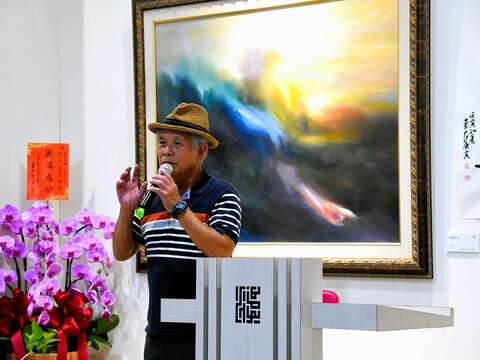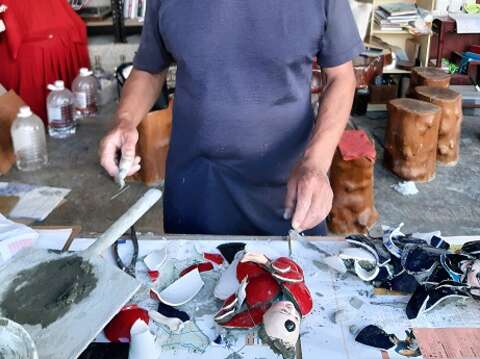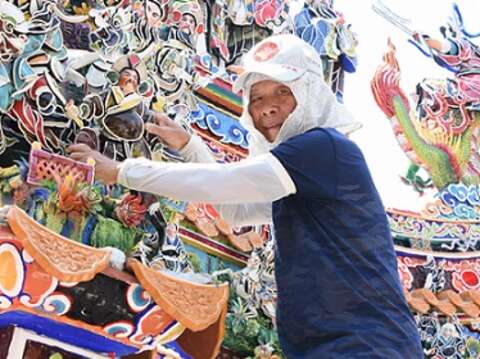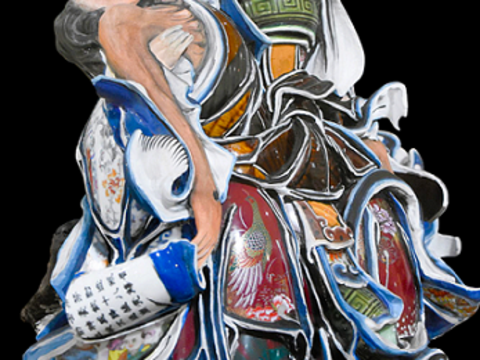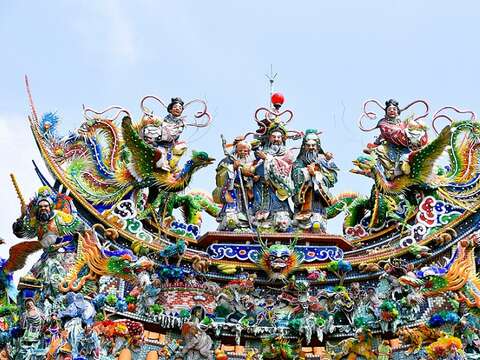Article 5 of the “League of Extraordinary Tainan People” series - Living National Treasure Chen San-huo Pioneers “Tap Instead of Cut” to Bring Koji Pottery into Art and Everyday Life
Posted Date:2025-04-04
339
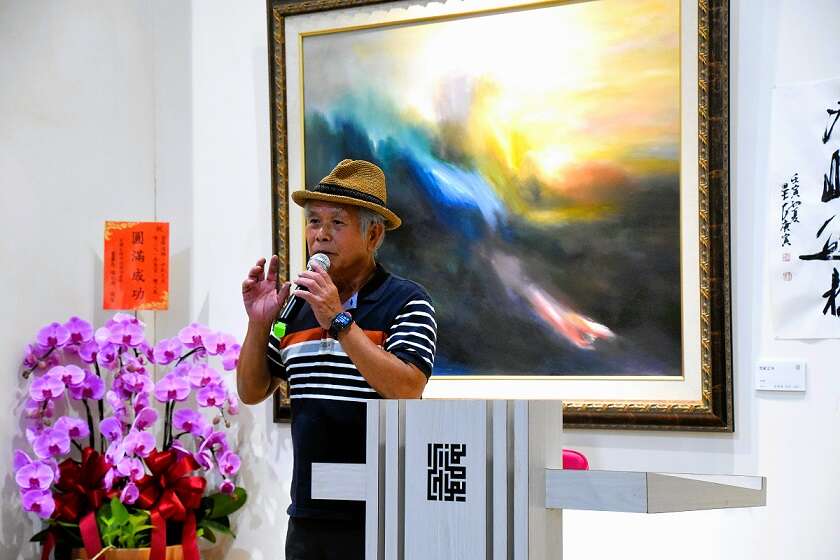
Introduce
Tainan has a rich cultural heritage and many talented people. To provide a more in-depth look at the diverse facets of Tainan, Tourism Bureau developed the “League Extraordinary Tainan People” series of articles in partnership with authors Chang Yun-su and Cheng Pei-wen to communicate the spirit and mindset of Tainan’s people through the life stories of master craftsmen. The articles offer the public a glimpse into the beauty of Tainan’s living culture, and provide a different kind of original itinerary in the form of corners and niches these people feel are worth exploring.
According to Tainan City Mayor Huang Wei-che, traditional koji pottery cut up materials such as as ceramics and glass and glued them to objects for decoration. The technique was mainly used in temples, private homes, rooftops, or carved stone walls. Chen San-huo is a national treasure who has mastered the essence of the koji technique. He then carved out his own niche and creative path through his unique tapping technique.
Director-General Lin Kuo-hua from the Tourism Bureau of Tainan City Government said that Chen San-huo, known as “Master Huo”, began apprenticing with his elder brother Li Shi-yi at the age of 17 and became the heir to the Northern Koji School. Once the apprenticeship was completed, the two brothers began working together and completed koji projects at more than a hundred temples throughout Taiwan. Later on, he was given the opportunity to work by himself on koji decorations for the carved stone walls at Puyan Temple in Madou. His technique impressed the temple and his fellow craftsmen so they recommended him to other temples as well. This would eventually lead to him starting his own business.
Chen San-huo started his own business at the age of 30 and built up a reputation for quality. Between the 1950s and 1980s, the vibrant development of folk religious beliefs spurred wave after wave of temple renovations, and Chen undertook commission after commission almost without pause. Beyond the 1980s however, the emergence of mass produced glazed ceramics meant that modular products became mainstream. The market for traditional koji pottery withered away and Chen’s business suffered. He stopped working for a while until the 1990s when he went to Fengyuan to help repair the Ciji Temple damaged by the September 21 Earthquake. There he was inspired to sculpt a Bodhidharma statue from the fragments of a broken vase lying nearby and invented the “Tap Instead of Cut” technique. When his elder brother suddenly passed away, he decided to pass on the craft and began focusing on artistic creations.
Unlike traditional koji pottery where pieces of cut ceramics or glass were glued to clay, Chen San-huo broke vases, wine jars, and ceramic pots into pieces by tapping on them and used them as his creative media. This unique approach was quite environmentally friendly as well. Any utensil that ended up in his hands could be transformed from the mundane into an extraordinary work of art. Chen explained that tapping was different from cutting. Cutting followed a standard procedure while tapping was completely random. The shapes and curves that result from the tapping are glued to the character’s body, limbs, clothing or any other suitable location. The actual shape was left up to chance.
Chen’s visit to the Louvre in France provided him with further inspiration. He now interprets Western themes through Asian techniques. His “Pieta” became one of his signature artworks and made koji more suitable for everyday life. Chen is a man of vision who is always willing to experiment. He created a new and distinctive style that breathed new life into tradition without sacrificing their original meaning. His achievements garnered him many accolades including “Taiwan Crafts Workshop”, “Lifetime Achievement Award for Contribution to the Arts”, “Global Chinese Culture & Arts Award”, “Living National Treasure”, and “National Crafts Achievement Award.”
According to the Tourism Bureau, the “League of Extraordinary Tainan People” series of articles has been syndicated since March onwards. The articles will feature the life stories of Tainan master craftsmen and also invite the public to experience the unique style of Tainan. The Tourism Bureau added that April will be a supercharged month for Tainan. The city will not only host the 2025 National Middle School Athletics Games (4/19 ~ 24) for the first time after a hiatus of 22 years, but also the first-ever Hot Dog Cup (4/12 ~ 4/13) for furry friends. For more information on the latest tourist attractions and events in Tainan, please continue to follow the “Travel Tainan” website and the “Travel Tainan Facebook Fan Page.”
According to Tainan City Mayor Huang Wei-che, traditional koji pottery cut up materials such as as ceramics and glass and glued them to objects for decoration. The technique was mainly used in temples, private homes, rooftops, or carved stone walls. Chen San-huo is a national treasure who has mastered the essence of the koji technique. He then carved out his own niche and creative path through his unique tapping technique.
Director-General Lin Kuo-hua from the Tourism Bureau of Tainan City Government said that Chen San-huo, known as “Master Huo”, began apprenticing with his elder brother Li Shi-yi at the age of 17 and became the heir to the Northern Koji School. Once the apprenticeship was completed, the two brothers began working together and completed koji projects at more than a hundred temples throughout Taiwan. Later on, he was given the opportunity to work by himself on koji decorations for the carved stone walls at Puyan Temple in Madou. His technique impressed the temple and his fellow craftsmen so they recommended him to other temples as well. This would eventually lead to him starting his own business.
Chen San-huo started his own business at the age of 30 and built up a reputation for quality. Between the 1950s and 1980s, the vibrant development of folk religious beliefs spurred wave after wave of temple renovations, and Chen undertook commission after commission almost without pause. Beyond the 1980s however, the emergence of mass produced glazed ceramics meant that modular products became mainstream. The market for traditional koji pottery withered away and Chen’s business suffered. He stopped working for a while until the 1990s when he went to Fengyuan to help repair the Ciji Temple damaged by the September 21 Earthquake. There he was inspired to sculpt a Bodhidharma statue from the fragments of a broken vase lying nearby and invented the “Tap Instead of Cut” technique. When his elder brother suddenly passed away, he decided to pass on the craft and began focusing on artistic creations.
Unlike traditional koji pottery where pieces of cut ceramics or glass were glued to clay, Chen San-huo broke vases, wine jars, and ceramic pots into pieces by tapping on them and used them as his creative media. This unique approach was quite environmentally friendly as well. Any utensil that ended up in his hands could be transformed from the mundane into an extraordinary work of art. Chen explained that tapping was different from cutting. Cutting followed a standard procedure while tapping was completely random. The shapes and curves that result from the tapping are glued to the character’s body, limbs, clothing or any other suitable location. The actual shape was left up to chance.
Chen’s visit to the Louvre in France provided him with further inspiration. He now interprets Western themes through Asian techniques. His “Pieta” became one of his signature artworks and made koji more suitable for everyday life. Chen is a man of vision who is always willing to experiment. He created a new and distinctive style that breathed new life into tradition without sacrificing their original meaning. His achievements garnered him many accolades including “Taiwan Crafts Workshop”, “Lifetime Achievement Award for Contribution to the Arts”, “Global Chinese Culture & Arts Award”, “Living National Treasure”, and “National Crafts Achievement Award.”
According to the Tourism Bureau, the “League of Extraordinary Tainan People” series of articles has been syndicated since March onwards. The articles will feature the life stories of Tainan master craftsmen and also invite the public to experience the unique style of Tainan. The Tourism Bureau added that April will be a supercharged month for Tainan. The city will not only host the 2025 National Middle School Athletics Games (4/19 ~ 24) for the first time after a hiatus of 22 years, but also the first-ever Hot Dog Cup (4/12 ~ 4/13) for furry friends. For more information on the latest tourist attractions and events in Tainan, please continue to follow the “Travel Tainan” website and the “Travel Tainan Facebook Fan Page.”
